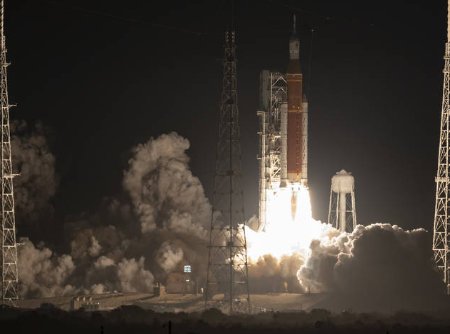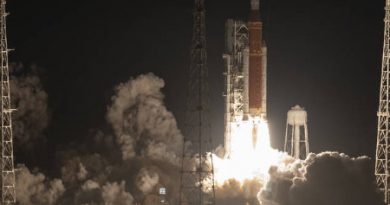Orion is launched to the Moon by NASA’s Artemis I Mega Rocket (science news).
As part of the Artemis programme, NASA’s Orion spacecraft is now in route to the Moon after the successful launch of the Space Launch System, the most powerful rocket in the world. SLS launched from Launch Pad 39B at NASA’s Kennedy Space Center in Florida today to conduct its first flight test.
The launch is the first step of a mission that will see Orion leave Earth and travel 40,000 miles beyond the Moon before returning in 25.5 days. The project, known as Artemis I, is an important component of NASA’s Moon to Mars exploration strategy, which emphasises exploration for the benefit of mankind. Before sending astronauts on the Artemis II mission, it is a crucial test for the organisation.
Orion’s solar arrays were deployed as it reached its maiden orbit, and engineers started checking out the spacecraft’s systems. The rocket’s upper stage engine successfully ignited for almost 18 minutes about 1.5 hours into the journey to provide Orion the powerful thrust it required to launch it out of Earth orbit and toward the Moon.
Orion has disengaged from its upper stage and is now travelling to the Moon with the assistance of its service module, which was developed by the ESA (European Space Agency) as part of an international partnership.
Ten tiny CubeSats, or small satellites for research and technology, will launch from a ring that linked the upper stage to the spacecraft throughout the course of the next several hours. Each CubeSat has a unique mission that may help close knowledge gaps about the solar system or showcase technology that might be used for designing missions to investigate the Moon and other celestial bodies in the future.
About eight hours after launch, Orion’s service module will also carry out the first of many burns to maintain Orion’s direction toward the Moon. Mission controllers at NASA’s Johnson Space Center in Houston will perform any further checkouts and course adjustments that are required during the next several days. On November 21, Orion is anticipated to fly past the Moon, making a near encounter to the lunar surface en route to a far-off retrograde orbit that is thousands of miles beyond the Moon and has a very stable orbit.
On Nov. 4th 2022, the Orion spacecraft and SLS rocket arrived at Kennedy’s Launch Pad 39B where they survived Hurricane Nicole. After the storm, personnel carefully examined the rocket, spacecraft, and related ground systems to make sure there had been no substantial effects from the bad weather.
Prior to Hurricane Ian, on September 26th 2022, engineers rolled the rocket back to the Vehicle Assembly Building (VAB) after rejecting two previous launch attempts on August 29th 2022 and September 4th 2022 respectively due to faulty temperature sensors and a liquid hydrogen leak at an interface between the rocket and mobile launcher. Teams successfully fixed the leak and showed new tanking techniques before rolling back to the VAB. Teams carried conducted routine maintenance while within the VAB to fix minor damage to the foam and cork on the thermal protection system and to recharge or swap out all of the system’s batteries.
The first woman and the first person of colour will touch down on the Moon via NASA’s Artemis missions, opening the door for a sustained lunar presence and acting as a stepping stone for humans travelling to Mars.
“What an incredible sight to see NASA’s Space Launch System rocket and Orion spacecraft launch together for the first time. This uncrewed flight test will push Orion to the limits in the rigors of deep space, helping us prepare for human exploration on the Moon and, ultimately, Mars,” NASA Administrator Bill Nelson told SFcrowsnest.




